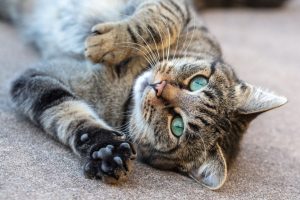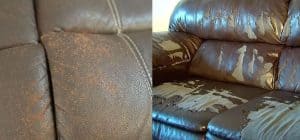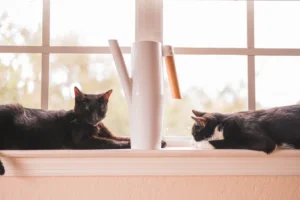Cats are known for their sharp claws, but why do they seem to have a particular affinity for clawing leather surfaces? Let’s explore the reasons behind this common feline behavior.
Cats claw leather for a variety of reasons, including marking their territory, maintaining their claws, and stretching their muscles. Understanding these motivations can help cat owners better address this behavior and protect their leather furniture.
Natural Instincts
Cats have an innate need to scratch and claw at surfaces, which traces back to their natural instincts. This behavior is deeply rooted in their evolutionary history as predators. In the wild, cats use their claws not only for hunting but also for self-defense and climbing trees. So, when your feline friend decides to scratch your leather sofa, they are simply following their instinctual drive.
Territory Marking
Aside from simply sharpening their claws, cats also use scratching as a way to mark their territory. By leaving visible scratch marks on surfaces like leather furniture, they are announcing to other animals in the household that this space belongs to them. Additionally, through their pheromones, cats leave behind scent markers when they scratch, further solidifying their claim on the area.
- To deter your cat from clawing at your leather items, consider providing alternative scratching surfaces such as scratching posts or pads.
- Regularly trim your cat’s nails to reduce the damage they can cause to your leather belongings.
- Reward your cat with treats or affection when they use the designated scratching area instead of your leather furniture.
For more insights into cat behavior, you can visit this resource for additional tips and information.
Claw Maintenance
Cats claw leather furniture not to be naughty, but to maintain their claws. Scratching helps them shed the old outer layer of their claws, keeping them sharp and healthy. Just like how we trim our nails, cats scratch to ensure their claws stay in top shape. So, when you see your furry friend going to town on your leather sofa, they’re just trying to keep their claws in tip-top condition.
Muscle Stretching
When cats claw leather, they’re not just sharpening their claws; they’re also giving their muscles a good stretch. Scratching helps them stretch their muscles, particularly in their shoulders and back. It’s like a feline yoga session! This stretching is essential for their overall physical health, keeping their muscles flexible and strong. So, next time you catch your cat scratching your leather furniture, remember they’re not just being mischievous – they’re also taking care of their well-being.
Additional Unique Insight:
Here are a few ways to redirect your cat’s scratching behavior:
- Provide plenty of scratching posts or pads in your home.
- Sprinkle catnip on appropriate scratching surfaces to attract your cat.
- Use positive reinforcement when your cat scratches in the right place.
- Trim your cat’s claws regularly to reduce the need for scratching.
Remember, understanding why your cat claws leather is the first step to helping them redirect this natural behavior effectively.
Alternative Surfaces
If your cat is drawn to your leather furniture like a magnet, providing alternative scratching surfaces is key. Opt for sturdy scratching posts covered in sisal rope or cardboard. Place these posts near the furniture they’ve been targeting to redirect their scratching behavior. Cats love variety, so consider offering different textures like carpet or wood to see what they prefer. Creating an enticing scratching area will help protect your prized possessions while keeping your feline friend happy and engaged.
Pro Tip: Sprinkle catnip on the scratching posts to attract your cat and encourage them to use the designated area for scratching.
Training and Deterrents
Training your cat to avoid clawing at leather furniture requires patience and consistency. Positive reinforcement is key – praise and reward your cat when they use appropriate scratching surfaces. Deterrents like double-sided tape, aluminum foil, or citrus sprays can be applied to furniture to discourage your cat from clawing. Remember to never punish your cat for scratching inappropriately as it can lead to anxiety and fear.
- Trim Their Nails: Regularly trimming your cat’s nails can help minimize damage to furniture.
- Provide Distractions: Keep your cat entertained with toys and interactive play to redirect their energy away from leather surfaces.
- Consider Soft Paws: Soft vinyl caps that fit over your cat’s claws can prevent them from causing damage when scratching.
For more in-depth training strategies and deterrent options, consult with a professional animal behaviorist or your veterinarian.
(The Humane Society offers a comprehensive guide on cat scratching behavior that you may find helpful.) [https://www.humanesociety.org/resources/cats-decoding-language-need-scratch-and-more]
Feline Enrichment
Cats claw leather not to spite you, but to fulfill their natural instincts. Providing them with mental and physical stimulation can greatly reduce this behavior. Enriching their environment with interactive toys, scratching posts, and puzzle feeders can keep them mentally engaged and physically active, diverting their attention away from leather furniture. Additionally, incorporating vertical spaces like cat trees or shelves allows them to climb and perch, satisfying their need for height and exploration. By catering to their natural instincts, you can help prevent leather clawing and enhance your cat’s overall well-being.
Unique Leathers
When it comes to why cats claw leather, it may surprise you that they may respond differently to various types of leather. While some cats may be attracted to the texture of faux leather, others might prefer exotic leathers like suede or patent leather. It’s essential to observe your cat’s behavior around different types of leather to understand their preferences. If your cat is particularly drawn to a specific type of leather, you can consider covering your furniture with a material that is less appealing to them, such as a smooth or less porous fabric. This simple adjustment can help protect your leather items from clawing and keep your cat satisfied.
- Leather Preferences: Cats may have unique preferences when it comes to leather, so pay attention to their reactions to different textures and materials.
- Alternative Options: If your cat is drawn to a specific type of leather, consider covering your furniture with a material that is less attractive to them.
- Observation is Key: By observing your cat’s behavior around various leathers, you can better understand their preferences and make informed decisions about protecting your furniture.
Remember that understanding your cat’s behavior and preferences is key to preventing them from clawing leather. By creating a stimulating environment and choosing suitable materials, you can help your feline friend thrive without damaging your furniture.
Fun Facts About Cat Behavior
Cats have a natural instinct to scratch and claw objects to maintain the health of their claws, stretch their muscles, and mark their territory. It’s a way for them to communicate through scent and visual markers. So, when your feline friend decides to claw on your leather furniture, it’s not to spite you but rather to satisfy their primal needs.
Did you know that the scent glands located in a cat’s paw pads release pheromones when they scratch? These pheromones help them mark their territory and create a sense of familiarity in their environment. Understanding this behavior can help you provide appropriate scratching posts and toys to redirect their natural instincts away from your prized leather possessions.
Here’s a unique insight for you: Cats’ claws are retractable, which means they can extend and retract their claws as needed. This feature allows them to keep their claws sharp and ready for hunting or defense but also enables them to use their claws for everyday activities like scratching on your leather furniture.
Overall, by recognizing and appreciating your cat’s innate behaviors and needs, you can create a harmonious living environment where both you and your feline friend can coexist happily without sacrificing your leather items to their scratching whims.
- Provide your cat with a variety of scratching posts made of different textures like sisal, cardboard, and carpet to satisfy their scratching urges.
- Trim your cat’s nails regularly to help minimize damage to your leather furniture.
- Use pheromone sprays or deterrents on your leather surfaces to discourage your cat from scratching in those areas.
Remember, a little understanding goes a long way in building a strong bond with your beloved furball and preserving your leather belongings.
Alex, a passionate animal lover, has experience in training and understanding animal behavior. As a proud pet parent to two dogs and three cats, he founded AnimalReport.net to share insights from animal experts and expand his knowledge of the animal kingdom.









